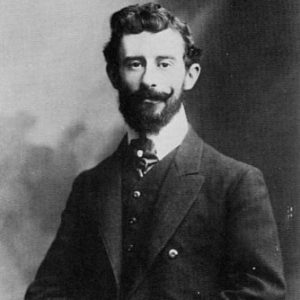 As a young French composer in his mid-twenties, Joseph Maurice Ravel joined with a number of other artists, musicians, poets, and assorted friends in Paris to form a group called “The Hooligans” ( Les Apaches in French, which makes you wonder about how a certain Native American tribe got its name). This was at the turn of the century—the 19th to 20th century, that is. Imagining the antics of twenty-something creative souls getting together makes the name they chose somehow appropriate. Claude Debussy and Igor Stravinsky were also members at one time or another.
As a young French composer in his mid-twenties, Joseph Maurice Ravel joined with a number of other artists, musicians, poets, and assorted friends in Paris to form a group called “The Hooligans” ( Les Apaches in French, which makes you wonder about how a certain Native American tribe got its name). This was at the turn of the century—the 19th to 20th century, that is. Imagining the antics of twenty-something creative souls getting together makes the name they chose somehow appropriate. Claude Debussy and Igor Stravinsky were also members at one time or another.
That hooligan spirit must have followed Ravel into his career when he composed his most famous and popular musical piece that he described as having “no form, properly speaking, no development, no or almost no modulation.” He said the music was inspired by the sounds of the machines in the factory his father worked in. His goal was to create a work of music that repeated over and over and over again, to see how long he could get away with it. The answer apparently was something in the neighborhood of fifteen to twenty minutes.
That piece of music was called Boléro.
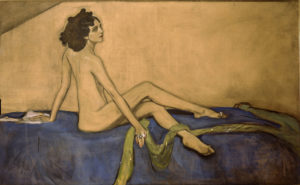 It all began when Ida Rubenstein, a prominent dancer, asked him to orchestrate a six-part piano composition called Iberia by Spanish composer Isaac Albéniz. (I guess she also liked to model nude for paintings.) But as Ravel was about to start work on it, he learned it had already been orchestrated and he was about to violate copyright law.
It all began when Ida Rubenstein, a prominent dancer, asked him to orchestrate a six-part piano composition called Iberia by Spanish composer Isaac Albéniz. (I guess she also liked to model nude for paintings.) But as Ravel was about to start work on it, he learned it had already been orchestrated and he was about to violate copyright law.
Not wishing to be that much of a hooligan, he decided instead to orchestrate one of his own compositions. Apparently wanting nevertheless to keep a touch of hooliganism in his life, he changed his mind again and decided to create a whole new musical work.
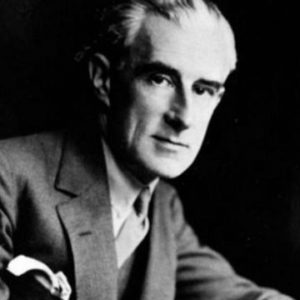 He developed a melody for it and, while on vacation, played the melody to a friend with one finger. (Played the melody with one finger, not that his friend had one finger.) When he finished, he said, “Don’t you think this theme has an insistent quality? I’m going to try and repeat it a number of times without any development.”
He developed a melody for it and, while on vacation, played the melody to a friend with one finger. (Played the melody with one finger, not that his friend had one finger.) When he finished, he said, “Don’t you think this theme has an insistent quality? I’m going to try and repeat it a number of times without any development.”
He named the piece Fandango after a type of Spanish dance. At some later point he changed his mind yet again and named it after a different Spanish dance, the boléro.
What a hooligan!
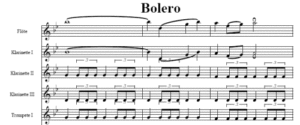 Boléro consists of a single theme—a very, very long theme—a very sophisticated and intricate theme. It does indeed proceed relentlessly with the rhythmic beat of marching soldiers or, you guessed it, factory machines. When the theme ends, it immediately starts over again—the exact same melody. It starts out incredibly quiet and slowly builds in volume, adding more instruments from the orchestra as it goes, until it ends in a mighty and abrupt crescendo. I’m sure lots of peope have counted how many times it repeats, but I haven’t, and I don’t think I want to know. I think it might rob some of the magic from it to know how often it repeats as it goes on and on and on and on…
Boléro consists of a single theme—a very, very long theme—a very sophisticated and intricate theme. It does indeed proceed relentlessly with the rhythmic beat of marching soldiers or, you guessed it, factory machines. When the theme ends, it immediately starts over again—the exact same melody. It starts out incredibly quiet and slowly builds in volume, adding more instruments from the orchestra as it goes, until it ends in a mighty and abrupt crescendo. I’m sure lots of peope have counted how many times it repeats, but I haven’t, and I don’t think I want to know. I think it might rob some of the magic from it to know how often it repeats as it goes on and on and on and on…
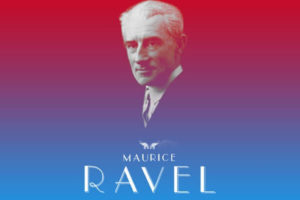 The composition was so bizarre and experimental that Ravel figured no orchestra would ever want to play it. But it premiered at the Paris Opéra in 1928 and was a smash hit. It became his most famous work, which boggled his mind.
The composition was so bizarre and experimental that Ravel figured no orchestra would ever want to play it. But it premiered at the Paris Opéra in 1928 and was a smash hit. It became his most famous work, which boggled his mind.
One of the more well-known renditions of it is in the movie 10 with Dudley Moore and Bo Derek, where Bo plays it when she tries to seduce Dudley. It certainly can be considered an erotic work with its relentless, thrusting rhythm building to a crescendo.
It’s a testament to Ravel’s eccentric genius that he was able to concoct a theme of music so intriguing and complex that constant repetitions of it never grows tiresome. It’s also a testament to him that some hooligan animators used it as inspiration for one of the most bizarre and fascinating short animations ever conceived as the glop from a Coke bottle discarded by astronauts visiting another planet evolves before our eyes into a planetfull of creatures, with a cynical, satirical punch at the end.
This seems to me to be the ideal way to present Maurice Ravel’s Boléro in its entirety accompanied by images of cinematic craziness to match one of the most peculiar musical compositions in Western culture. Appropriately the film is called “March of the Dinosaurs.”